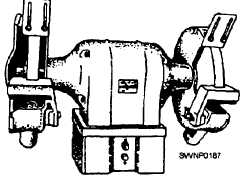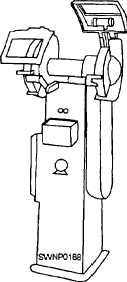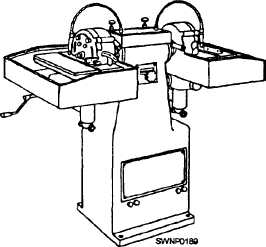CHAPTER 12 STEELWORKER TOOLS AND EQUIPMENT
In the shop and out on a jobsite, you will be using grinders, portable power drills, compressors, saws, and various other tools. As a Steelworker you need to be thoroughly familiar with the operation and maintenance of these tools as well as all applicable safety precautions.
BENCH AND PEDESTAL GRINDERS
The common bench and pedestal grinders are the simplest and most widely used grinding machines. The grinding work done with them is called OFFHAND GRINDING. Offhand grinding is used for work on pieces that can be held in the hands and controlled until ground to the desired shape or size. This work is done when the piece king ground does not require great precision or accuracy.
The bench grinder (fig. 12-1) is attached to a bench or table. The grinding wheels mount directly onto the motor shaft. One wheel is coarse for rough grinding, and the other is fine for finish grinding.
The pedestal grinder, inmost cases, is larger than the bench grinder and is equipped with a base and pedestal fastened to the floor. The DRY TYPE (fig. 12-2) has no arrangement for cooling the work while grinding other than a water container into which the piece can be dipped to cool it. The WET TYPE (fig. 12-3) is equipped with a built-in coolant system that keeps the wheels constantly drenched with fluid. The coolant washes away particles of loose abrasive material, as well as metal, and keeps the piece cool.

Figure 12-1.-The bencb grinder, Eye shields have not been mounted.

Figure 12-2.-The pedestal grinder (dry type).

Figure 12-3.-Pedestal grinder (wet type) wttb a built-in coolant system
Bench and pedestal grinders are dangerous if they are not used correctly They must never be used unless fitted with guards and safety glass EYE SHIELDS (fig. 12-4). Even then you must wear goggles or safety glasses. A TOOL REST is furnished to support the work while grinding. It should be adjusted to come within one eighth of an inch from the wheels. This will
Continue Reading